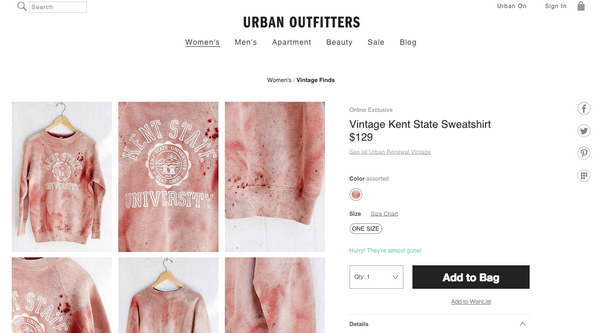By KACIE NELSON
I last posted about how social media, more specifically Twitter, are becoming a very integral part of how news is not only spread, but also generated in today’s culture. Once again, the social media giant strikes again, this time bringing to light a very distasteful issue.
Earlier this week, it came to light that the popular brand, Urban Outfitters, was selling a “vintage” Kent State sweatshirt. What was interesting about this item wasn’t that it was supposedly “vintage”; not that it was the only one for sale; not even that it was being sold for an outlandish $129!
What made this particular item so buzz-worthy was its design. It contained what appeared to be blood stains surrounding holes in the shirt (presumed to be bullet holes), reminiscent of the 1970 “Kent State Massacre.”
Forty-four years ago, the Ohio National Guard opened fire on a group of unarmed students, leaving four dead and nine injured.
The image of the sweatshirt on the Urban Outfitters website spread like wild fire on social media, after being posted on the popular website Buzzfeed. Outrage ensued and spurred Kent State officials to write Urban Outfitters a letter expressing their disgust.
Urban Outfitters released a full apology to Kent State and all those offended by the sweatshirt, claiming that the dye pattern was a result of poor coloring on the sweatshirt, and the holes were due to wear and tear.
Obviously, this did not pacify anyone.
Why would Urban Outfitters buy and sell such a distasteful and offensive item? Was it an honest mistake?
We may never know, but luckily for us we’ll always have Twitter to vent and get our opinions heard.




